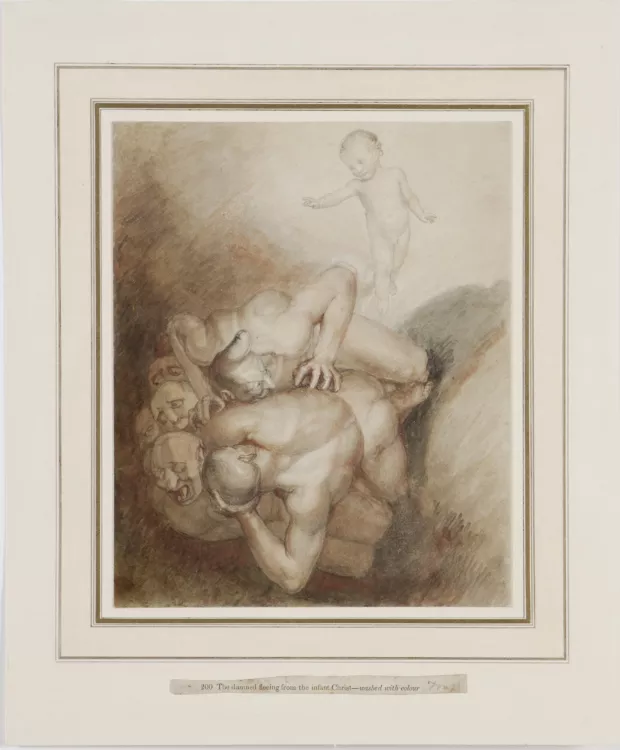Height
18 cm
Width
18 cm
Medium
Genre
Description
This image is an illustration for paragraph 1271 of Emanuel Swedenborg's Arcana Coelestia. This paragraph describes demons who
supposed that they had all power to do what they pleased, and that they could take away life from everyone: but to expose the vanity of this imagination, they were thrust down again to their infernal abodes by a little child, at whose presence they began so to totter and tremble that they could not help expressing their anguish by cries. (Swedenborg 76)
A toddler, identified in the image subtitle as the "infant Christ," extends a hand over a group of grotesque, gargoyle-like figures writhing in pain. The child is illumined, while the other figures are cast in shadow. In this image, the victory of the tiny child over the grotesque demons simultaneously demonstrates the awesome power of Christian purity while maintaining—in the mundane innocence of the child—the basic and foundational nature of such triumph.
Flaxman was better known as a sculptor than as a painter, but his illustrations illuminated literature and demonstrated his classical influences. He was also an influence on Romantic art, as he introduced William Blake to the New Jerusalem Church (Rix 54). Evil Spirits Cast Out likely brought new attention to Swedenborg’s work and to his innovative ideas regarding religion. Even today, the claim (discussed by Swedenborg) that all religions are equally valid is considered somewhat radical. Flaxman’s image uses light and shadow to accentuate the contrast between the purity of the child and the depravity of the evil spirits. Though his watercolor is less dramatic than the mezzotints of artists like John Martin, he captures the drama of spiritual battles very effectively.
Associated Persons
Associated Works
Locations Description
The New Jerusalem Church was founded in England in 1778 and in America in 1792. Its followers believe that Swedenborg was a prophet, that God does not judge people, and that all religions are good and valid paths to Heaven (Barrett 287ff). Though Flaxman supported Swedenborg’s ideas, he remained an Anglican (Scott & Fowles 9).
Copyright
Copyright 2009, Chazen Museum of Art, University of Wisconsin-Madison
Publisher
Emanuel Swedenborg
Collection
Accession Number
1999.68
Additional Information
Bibliography
Barrett, Benjamin Fiske. Lectures on the Doctrines of the New Christian Church. New York: Michigan and Northern Indiana Association of the New Church, 1852. Print.
Gyllenhaal, Martha. John Flaxman’s Illustrations to Emanuel Swedenborg’s Arcana Coelestia. Philadelphia: Temple University Press, 1994.
Irwin, David. John Flaxman 1755-1826. London: Studio Vista and Christie’s, 1979.
Rix, Robert. William Blake and the Cultures of Radical Christianity. Burlington: Ashgate, 2007. Print.
Scott & Fowles, and Martin Birnbaum. Catalogue of an Exhibition of Original Drawings by John Flaxman, R.A. New York: Scott & Fowles, 1910. Print.
Swedenborg, Emanuel. Arcana Coelestia. New York: The American Swedenborg Printing and Society, 1910. Print.

